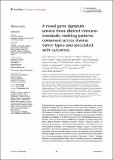Por favor, use este identificador para citar o enlazar a este item:
http://hdl.handle.net/10261/285350COMPARTIR / EXPORTAR:
 SHARE SHARE
 CORE
BASE CORE
BASE
|
|
| Visualizar otros formatos: MARC | Dublin Core | RDF | ORE | MODS | METS | DIDL | DATACITE | |

| Título: | A novel gene signature unveils three distinct immune-metabolic rewiring patterns conserved across diverse tumor types and associated with outcomes |
Autor: | Pedrosa, Leire; Foguet, Carles; Oliveres, Helena; Archilla, Iván; García de Herreros, Marta; Rodríguez, Adela; Postigo, Antonio; Benítez-Ribas, Daniel; Camps, Jordi ; Cuatrecasas, Miriam; Castells, Antoni; Prat, Aleix; Thomson, Timothy M. CSIC ORCID ; Maurel, Joan; Cascante, Marta CSIC ORCID | Palabras clave: | Biomarker Immunotherapy Precision medicine Metabolism Immune checkpoint-based therapy |
Fecha de publicación: | 2-sep-2022 | Editor: | Frontiers Media | Citación: | Frontiers in Immunology 13: 926304 (2022) | Resumen: | Existing immune signatures and tumor mutational burden have only modest predictive capacity for the efficacy of immune check point inhibitors. In this study, we developed an immune-metabolic signature suitable for personalized ICI therapies. A classifier using an immune-metabolic signature (IMMETCOLS) was developed on a training set of 77 metastatic colorectal cancer (mCRC) samples and validated on 4,200 tumors from the TCGA database belonging to 11 types. Here, we reveal that the IMMETCOLS signature classifies tumors into three distinct immune-metabolic clusters. Cluster 1 displays markers of enhanced glycolisis, hexosamine byosinthesis and epithelial-to-mesenchymal transition. On multivariate analysis, cluster 1 tumors were enriched in pro-immune signature but not in immunophenoscore and were associated with the poorest median survival. Its predicted tumor metabolic features suggest an acidic-lactate-rich tumor microenvironment (TME) geared to an immunosuppressive setting, enriched in fibroblasts. Cluster 2 displays features of gluconeogenesis ability, which is needed for glucose-independent survival and preferential use of alternative carbon sources, including glutamine and lipid uptake/β-oxidation. Its metabolic features suggest a hypoxic and hypoglycemic TME, associated with poor tumor-associated antigen presentation. Finally, cluster 3 is highly glycolytic but also has a solid mitochondrial function, with concomitant upregulation of glutamine and essential amino acid transporters and the pentose phosphate pathway leading to glucose exhaustion in the TME and immunosuppression. Together, these findings suggest that the IMMETCOLS signature provides a classifier of tumors from diverse origins, yielding three clusters with distinct immune-metabolic profiles, representing a new predictive tool for patient selection for specific immune-metabolic therapeutic approaches. | Versión del editor: | http://dx.doi.org/10.3389/fimmu.2022.926304 | URI: | http://hdl.handle.net/10261/285350 | DOI: | 10.3389/fimmu.2022.926304 | Identificadores: | doi: 10.3389/fimmu.2022.926304 e-issn: 1664-3224 |
| Aparece en las colecciones: | (IBMB) Artículos |
Ficheros en este ítem:
| Fichero | Descripción | Tamaño | Formato | |
|---|---|---|---|---|
| A novel gene signature_Pedrosa_PV_Art2022.pdf | 17,76 MB | Adobe PDF |  Visualizar/Abrir |
CORE Recommender
SCOPUSTM
Citations
2
checked on 27-mar-2024
WEB OF SCIENCETM
Citations
2
checked on 26-feb-2024
Page view(s)
97
checked on 18-abr-2024
Download(s)
71
checked on 18-abr-2024
Google ScholarTM
Check
Altmetric
Altmetric
Este item está licenciado bajo una Licencia Creative Commons

